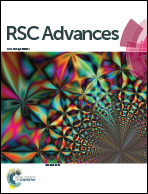Hybrid core–shell nanostructured electrodes made of polypyrrole nanotubes coated with Ni(OH)2 nanoflakes for high energy-density supercapacitors
Abstract
This work describes the design of Ni(OH)2@PPy-NTs core–shell nanostructures with potential application as an electrode material for supercapacitors. Initially, one dimensional (1D) polypyrrole nanotubes (PPy-NTs) were synthesized through a chemical oxidation mediated soft template-directed route using as the anion the azo dye methyl orange (MO). Subsequently, three dimensional (3D) Ni(OH)2 nanoflakes were grown onto PPy-NTs by a simple hydrothermal route. This exclusive Ni(OH)2@PPy-NTs nano-architecture helps to improve the overall electrochemical performance of the electrode, due to the high surface area provided by 3D nanoflakes and excellent electronic/ionic conductivity of 1D nanotubes. The maximum specific capacitance obtained for Ni(OH)2@PPy-NTs was 536 F g−1 with good capacity retention after 1000 charge/discharge cycles. Last but not least, EIS technique showed a low electrochemical series resistance for Ni(OH)2@PPy-NTs confirming their promise as a high-performance energy storage material.


 Please wait while we load your content...
Please wait while we load your content...